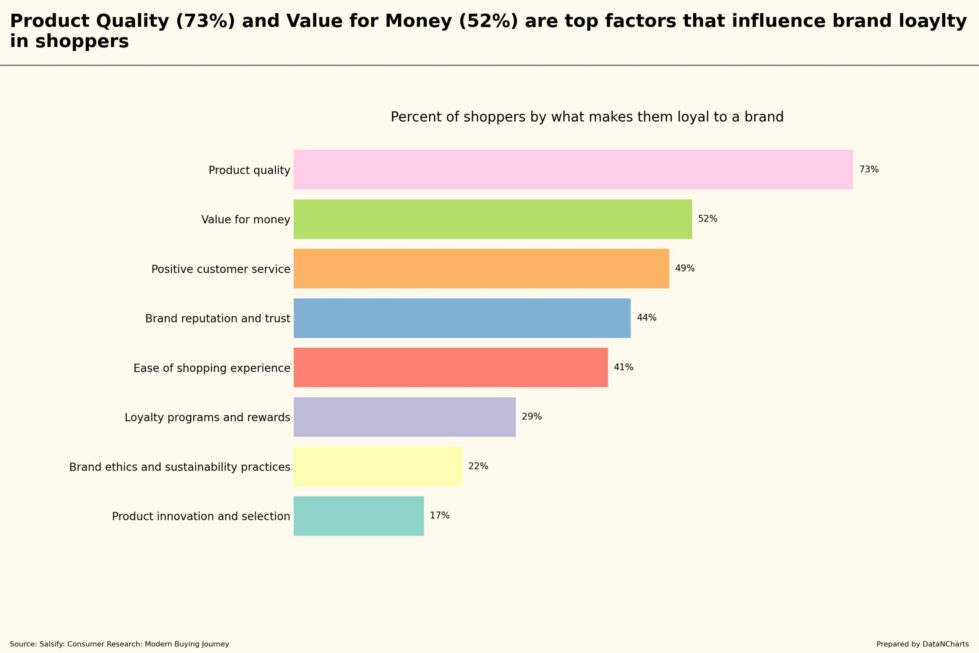Data Highlights
Nearly three-quarters (73%) of shoppers stay loyal to brands that consistently deliver high product quality.
More than half (52%) value brands that offer good value for money.
Nearly half (49%) remain loyal due to positive customer service, while a similar share (44%) prioritize brand trust and reputation.
About four in ten (41%) continue shopping with brands that provide a seamless shopping experience.
Nearly one-third (29%) are motivated by loyalty programs and rewards.
More than one in five (22%) consider brand ethics and sustainability practices important for loyalty.
A negligible share (17%) values product innovation and selection as a primary factor.
Scope
Understanding what drives brand loyalty helps retailers improve customer retention and long-term sales. With growing competition in e-commerce, brands must prioritize shopper needs effectively. This brief explores key loyalty drivers and provides insights into optimizing the shopper journey to increase repeat purchases.
Product Quality is the Leading Loyalty Driver (73%)
Nearly three-quarters (73%) of shoppers remain loyal to brands that consistently deliver high product quality. Reliability in performance, durability, and overall satisfaction keeps customers coming back. Brands ensuring strict quality control and clear product expectations maintain stronger customer loyalty.
However, pricing also plays a crucial role in long-term commitment.
Value for Money Strengthens Brand Loyalty (52%)
More than half (52%) of shoppers continue buying from brands that offer competitive pricing and good value. Shoppers weigh cost against quality when making repeat purchases. Brands focusing on transparent pricing, fair discounts, and value-driven messaging retain price-conscious customers effectively.
Beyond price, customer experience is another key loyalty factor.
Customer Service and Brand Reputation Influence Retention (49%, 44%)
Nearly half (49%) of shoppers stay loyal to brands offering strong customer service. Quick responses, helpful support teams, and easy resolutions build lasting trust. Similarly, 44% of shoppers prioritize brand reputation, reinforcing the need for consistent messaging and trust-building practices.
While service and trust build relationships, ease of shopping is just as critical.
Shopping Convenience Boosts Loyalty (41%)
More than four in ten (41%) shoppers continue purchasing from brands that make shopping effortless. Seamless website navigation, mobile-friendly experiences, and efficient checkout processes reduce friction and improve customer retention. Retailers optimizing ease of purchase strengthen long-term brand loyalty.
Beyond convenience, rewards programs play a role in engagement.
Loyalty Programs Keep Customers Engaged (29%)
Nearly one-third (29%) of shoppers appreciate loyalty programs and rewards. Discounts, points-based systems, and exclusive perks encourage repeat purchases. Brands integrating well-structured rewards programs improve retention and increase lifetime customer value.
Ethical practices also contribute to loyalty for a select group of shoppers.
Brand Ethics and Sustainability Matter to Some (22%)
More than one in five (22%) shoppers prefer brands committed to ethical sourcing and sustainability. While not the top loyalty driver, this factor resonates strongly with value-driven consumers. Brands emphasizing sustainability attract and retain mission-driven shoppers.
Meanwhile, product innovation plays the smallest role in loyalty.
Product Innovation and Selection Have Limited Impact (17%)
A negligible share (17%) of shoppers remain loyal to brands due to product innovation and selection. While variety is important, most consumers prioritize product reliability, pricing, and overall experience over frequent updates or expanded selections.
Insights and Opportunities
Shoppers remain loyal to brands that consistently deliver quality, value, and a seamless experience. Retailers must refine strategies to align with these key loyalty drivers.
- Firstly, brands must prioritize product quality and consistency. Maintaining high-quality standards reduces churn and improves brand reputation. Brands investing in product excellence can expect increased repeat purchases, reduced return rates, and higher customer satisfaction. Measure effectiveness through repeat purchase rates, return rates, and customer satisfaction scores.
- Secondly, brands must emphasize competitive pricing and value-driven messaging. Offering clear pricing, bundled discounts, and price-match guarantees strengthens shopper trust. Brands optimizing pricing strategies can expect improved customer retention, higher average order values, and stronger brand preference. Track success through customer lifetime value, conversion rate improvements, and sales growth from repeat customers.
- Finally, seamless customer experience and personalized rewards drive long-term engagement. Simplified checkout, fast customer service, and well-structured loyalty programs keep customers returning. Brands focusing on experience optimization will see reduced friction, increased engagement, and stronger brand advocacy. Evaluate performance through loyalty program engagement, shopping cart completion rates, and repeat visit frequency.
By aligning strategies with shopper loyalty drivers, brands can increase retention, improve shopper path to purchase, and drive long-term business success.
